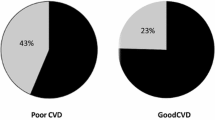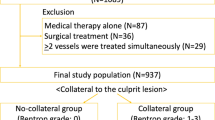Abstract
Background
The development of coronary collaterals is crucial to survival through acute ischemia. Mild to moderate loss of renal function has been suggested to play a role in this event, but evidential data are scarce. The aim of this study was to investigate the relationship between mild to moderate renal insufficiency and coronary collateral development in patients with chronic total coronary artery occlusion.
Methods and results
A total of 83 patients with mild to moderate loss of renal function (30 mL/min/1.73 m2 ≤ eGFR < 90 mL/min/1.73 m2) with chronic total coronary artery occlusion were included in our study. The collateral circulation was graded according to Rentrop classification and the function of collateral circulation was graded according to Werner collateral connection (CC) grades. Compared to patients with good collateral circulation (Rentrop = 2,3), eGFR was found to be lower in those patients with poor coronary collateral circulation (Rentrop = 0,1) (63.30 ± 10.51 vs. 54.13 ± 10.56, P = 0.02). eGFR was also found to be lower in poorly functioning coronary collateral circulation (CC = 0,1) than in efficiently functioning coronary collateral circulation (CC = 2) (55.22 ± 9.98 vs. 66.28 ± 9.16, P = 0.03). Multiple logistic regression analysis showed that low eGFR was independently associated with poor coronary collateral circulation (Rentrop = 0,1, 95% CI, 0.09–1.09, P = 0.044) and poor function of coronary collateral circulation (CC = 0,1, 95% CI, 0.02–0.17, P = 0.02).
Conclusions
Lower eGFR is associated with poorer coronary collateral vessel development in patients experiencing mild to moderate renal insufficiency. Moreover, eGFR represents an independent factor affecting coronary collateral vessel development.


Similar content being viewed by others
References
Seiler C (2003) The human coronary collateral circulation. Heart 89:1352–1357
Zbinden R, Zbinden S, Billinger M, Windecker S, Meier B, Seiler C (2005) Influence of diabetes mellitus on coronary collateral flow: an answer to an old controversy. Heart 91:1289–1293
Werner GS, Gitt AK, Zeymer U, Juenger C, Towae F, Wienbergen H, Senges J (2009) Chronic total coronary occlusions in patients with stable angina pectoris: impact on therapy and outcome in present day clinical practice. Clin Res Cardiol 98:435–441
Hirai T, Fujita M, Nakajima H, Asanoi H, Yamanishi K, Ohno A, Sasayama S (1989) Importance of collateral circulation for prevention of left ventricular aneurysm formation in acute myocardial infarction. Circulation 79:791–796
Habib GB, Heibig J, Forman SA, Brown BG, Roberts R, Terrin ML, Bolli R (1991) Influence of coronary collateral vessels on myocardial infarct size in humans. Results of phase I thrombolysis in myocardial infarction (TIMI) trial. The TIMI Investigators. Circulation 83:739–746
Billinger M, Kloos P, Eberli FR, Windecker S, Meier B, Seiler C (2002) Physiologically assessed coronary collateral flow and adverse cardiac ischemic events: a follow-up study in 403 patients with coronary artery disease. J Am Coll Cardiol 40:1545–1550
Koerselman J, van der Graaf Y, de Jaegere PP, Grobbee DE (2003) Coronary collaterals: an important and underexposed aspect of coronary artery disease. Circulation 107:2507–2511
Schirmer SH, Fledderus JO, Bot PT, Moerland PD, Hoefer IE, Baan J Jr, Henriques JP, van der Schaaf RJ, Vis MM, Horrevoets AJ, Piek JJ, van Royen N (2008) Interferon-beta signaling is enhanced in patients with insufficient coronary collateral artery development and inhibits arteriogenesis in mice. Circ Res 102:1286–1294
Matsuo Y, Imanishi T, Hayashi Y, Tomobuchi Y, Kubo T, Hano T, Akasaka T (2008) The effect of endothelial progenitor cells on the development of collateral formation in patients with coronary artery disease. Intern Med 47:127–134
Henry RM, Kostense PJ, Bos G, Dekker JM, Nijpels G, Heine RJ, Bouter LM, Stehouwer CD (2002) Mild renal insufficiency is associated with increased cardiovascular mortality: the Hoorn Study. Kidney Int 62:1402–1407
Perticone F, Maio R, Tripepi G, Zoccali C (2004) Endothelial dysfunction and mild renal insufficiency in essential hypertension. Circulation 110:821–825
Stam F, van Guldener C, Becker A, Dekker JM, Heine RJ, Bouter LM, Stehouwer CD (2006) Endothelial dysfunction contributes to renal function-associated cardiovascular mortality in a population with mild renal insufficiency: the Hoorn study. J Am Soc Nephrol 17:537–545
Zoccali C, Maio R, Tripepi G, Mallamaci F, Perticone F (2006) Inflammation as a mediator of the link between mild to moderate renal insufficiency and endothelial dysfunction in essential hypertension. J Am Soc Nephrol 17:S64–S68
Abaci A, Oguzhan A, Kahraman S, Eryol NK, Unal S, Arinc H, Ergin A (1999) Effect of diabetes mellitus on formation of coronary collateral vessels. Circulation 99:2239–2242
Van Belle E, Rivard A, Chen D, Silver M, Bunting S, Ferrara N, Symes JF, Bauters C, Isner JM (1997) Hypercholesterolemia attenuates angiogenesis but does not preclude augmentation by angiogenic cytokines. Circulation 96:2667–2674
Werner GS, Jandt E, Krack A, Schwarz G, Mutschke O, Kuethe F, Ferrari M, Figulla HR (2004) Growth factors in the collateral circulation of chronic total coronary occlusions: relation to duration of occlusion and collateral function. Circulation 110:1940–1945
Levey AS, Coresh J, Balk E, Kausz AT, Levin A, Steffes MW, Hogg RJ, Perrone RD, Lau J, Eknoyan G (2003) National Kidney Foundation practice guidelines for chronic kidney disease: evaluation, classification, and stratification. Ann Intern Med 139:137–147
Levey AS, Bosch JP, Lewis JB, Greene T, Rogers N, Roth D (1999) A more accurate method to estimate glomerular filtration rate from serum creatinine: a new prediction equation. Modification of Diet in Renal Disease Study Group. Ann Intern Med 130:461–470
Fazlioglu M, Senturk T, Kumbay E, Kaderli AA, Yilmaz Y, Ozdemir B, Baran I, Aydinlar A (2009) Small arterial elasticity predicts the extent of coronary artery disease: relationship with serum uric acid. Atherosclerosis 202:200–204
Wannamethee G, Shaper AG (1992) Alcohol and sudden cardiac death. Br Heart J 68:443–448
Rentrop KP, Cohen M, Blanke H, Phillips RA (1985) Changes in collateral channel filling immediately after controlled coronary artery occlusion by an angioplasty balloon in human subjects. J Am Coll Cardiol 5:587–592
Werner GS, Ferrari M, Heinke S, Kuethe F, Surber R, Richartz BM, Figulla HR (2003) Angiographic assessment of collateral connections in comparison with invasively determined collateral function in chronic coronary occlusions. Circulation 107:1972–1977
Thambyrajah J, Landray MJ, McGlynn FJ, Jones HJ, Wheeler DC, Townend JN (2000) Abnormalities of endothelial function in patients with predialysis renal failure. Heart 83:205–209
Stam F, van Guldener C, Schalkwijk CG, ter Wee PM, Donker AJ, Stehouwer CD (2003) Impaired renal function is associated with markers of endothelial dysfunction and increased inflammatory activity. Nephrol Dial Transplant 18:892–898
Ito WD, Arras M, Scholz D, Winkler B, Htun P, Schaper W (1997) Angiogenesis but not collateral growth is associated with ischemia after femoral artery occlusion. Am J Physiol 273:H1255–H1265
Ziche M, Parenti A, Ledda F, Dell’Era P, Granger HJ, Maggi CA, Presta M (1997) Nitric oxide promotes proliferation and plasminogen activator production by coronary venular endothelium through endogenous bFGF. Circ Res 80:845–852
Sezer M, Ozcan M, Okcular I, Elitok A, Umman S, Umman B, Tayyareci Y, Olcay A, Nisanci Y, Bilge AK, Meric M (2007) A potential evidence to explain the reason behind the devastating prognosis of coronary artery disease in uraemic patients: renal insufficiency is associated with poor coronary collateral vessel development. Int J Cardiol 115:366–372
Fried LF, Shlipak MG, Crump C, Bleyer AJ, Gottdiener JS, Kronmal RA, Kuller LH, Newman AB (2003) Renal insufficiency as a predictor of cardiovascular outcomes and mortality in elderly individuals. J Am Coll Cardiol 41:1364–1372
Go AS, Chertow GM, Fan D, McCulloch CE, Hsu CY (2004) Chronic kidney disease and the risks of death, cardiovascular events, and hospitalization. N Engl J Med 351:1296–1305
Luke RG (1992) Can we prevent end-stage renal disease due to hypertension or to diabetes mellitus? JAMA 268:3119–3120
Palmer BF (2008) Management of hypertension in patients with chronic kidney disease and diabetes mellitus. Am J Med 121:S16–S22
Akmal M, Kasim SE, Soliman AR, Massry SG (1990) Excess parathyroid hormone adversely affects lipid metabolism in chronic renal failure. Kidney Int 37:854–858
Werner GS, Ferrari M, Betge S, Gastmann O, Richartz BM, Figulla HR (2001) Collateral function in chronic total coronary occlusions is related to regional myocardial function and duration of occlusion. Circulation 104:2784–2790
Tanaka T, Fujita M, Nakae I, Tamaki S, Hasegawa K, Kihara Y, Nohara R, Sasayama S (1998) Improvement of exercise capacity by sarpogrelate as a result of augmented collateral circulation in patients with effort angina. J Am Coll Cardiol 32:1982–1986
Duncker DJ, Bache RJ (2008) Regulation of coronary blood flow during exercise. Physiol Rev 88:1009–1086
Foreman BW, Dai XZ, Bache RJ (1991) Vasoconstriction of canine coronary collateral vessels with vasopressin limits blood flow to collateral-dependent myocardium during exercise. Circ Res 69:657–664
Acknowledgments
This study was supported by grants from the National Natural Science Foundation of China (No. 30770899 to Ruqiong Nie, No. 81000101 to Shuanglun Xie), the Natural Science Foundation of Guangdong Province (No. 8151008901000072 to Ruqiong Nie), and the Young Teacher Foundation of Sun Yat-sen University (No. 2008001 to Shuanglun Xie).
Author information
Authors and Affiliations
Corresponding author
Additional information
S. Xie and H. Li contributed equally to this work.
Rights and permissions
About this article
Cite this article
Xie, Sl., Li, Hy., Deng, Bq. et al. Poor coronary collateral vessel development in patients with mild to moderate renal insufficiency. Clin Res Cardiol 100, 227–233 (2011). https://doi.org/10.1007/s00392-010-0233-8
Received:
Accepted:
Published:
Issue Date:
DOI: https://doi.org/10.1007/s00392-010-0233-8




